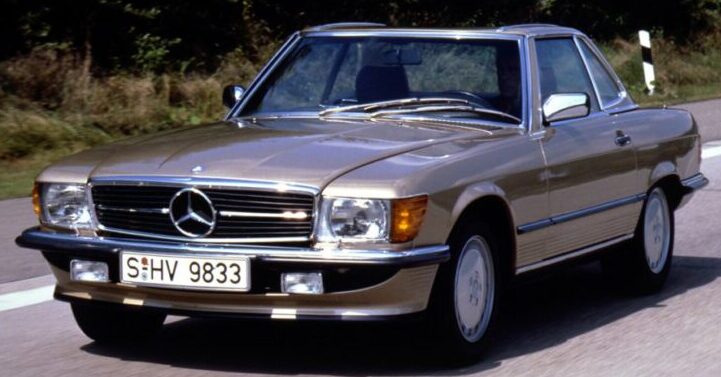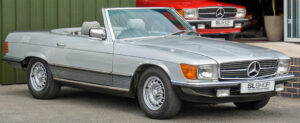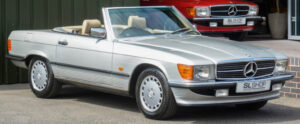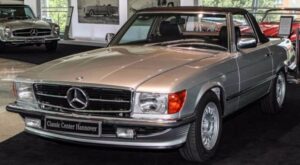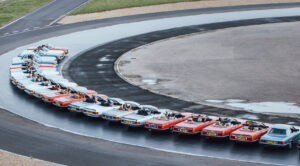Mercedes R107 or W107? Model history
The R107 SL over the years
Mercedes R107 or W107? The R107 SL, a series of luxury sports cars produced by Mercedes-Benz from 1971 to 1989, experienced a notable evolution over its production span. Initially introduced as a successor to the W113 “Pagoda” SL, the R107 SL brought a modernized design and advanced features to the luxury convertible segment.
Key milestones and changes in the R107 SL’s evolution include:
- 1971-1972: The R107 SL was launched in 1971 with two initial models: the 350SL and 350SLC. These models featured a 3.5-liter V8 engine and stylish design cues. The 350SL was a two-seater convertible, while the 350SLC was a fixed-roof coupe.
- 1973-1975: The 450SL was introduced in 1973, featuring a larger 4.5-liter V8 engine. This model became popular and is often associated with the R107 series. It offered improved performance and refinement.
- 1976-1980: The R107 received a facelift in 1976, which included changes to the front and rear bumpers to meet new safety regulations. The interior was also updated for a more modern feel.
- 1980-1981: The 380SL was introduced with a 3.8-liter V8 engine, aimed at improving fuel efficiency in response to changing market demands.
- 1985-1989: The final iteration of the R107 SL, the 560SL, was introduced in 1985. It featured a more powerful 5.6-liter V8 engine and various refinements in terms of comfort and technology.
Throughout its production run, the R107 SL maintained its reputation for luxurious open-top motoring and became an enduring symbol of prestige and style. Its classic design, durable build quality, and advanced features for its time contributed to its popularity and iconic status. The R107 SL remains a sought-after collectible today, appreciated by enthusiasts and collectors for its blend of elegance, performance, and historical significance.
The cult W107 SL
The Mercedes-Benz W107 SL, often referred to as a “cult” car, has garnered a dedicated and passionate following among automotive enthusiasts for several reasons:
Timeless Design: The W107 SL’s design, characterized by its elegant and iconic lines, has stood the test of time. Its classic proportions, graceful curves, and distinctive front grille contribute to its enduring appeal. The timeless design language of the W107 SL has made it a symbol of luxury and sophistication.
Open-Top Driving Experience: The W107 SL is a convertible, allowing occupants to enjoy the thrill of open-top motoring. This feature, combined with the car’s luxurious interior and comfortable ride, creates a unique driving experience that resonates with enthusiasts who appreciate the joy of driving in the open air.
Symbol of Status: Throughout its production years, the W107 SL was associated with luxury, wealth, and prestige. Owning a W107 SL became a symbol of social status, and this perception has carried over into its cult status. Many enthusiasts are drawn to the car’s aura of exclusivity and refinement.
Collectibility: As the years have passed, the W107 SL has gained recognition as a collectible classic car. Its limited production numbers and iconic status have contributed to its desirability among collectors. Enthusiasts often seek out well-preserved examples to add to their collections, further fueling its cult-like following.
Community and Events: The cult following of the W107 SL is also fueled by a vibrant community of enthusiasts, clubs, and events. Owners often come together to share their passion for these cars, exchange knowledge, and participate in gatherings, rallies, and shows. This sense of camaraderie and shared enthusiasm strengthens the cult status of the W107 SL.
Pop Culture Influence: The W107 SL has also made appearances in popular culture, further contributing to its cult status. Its appearances in movies, TV shows, and other media have helped solidify its image as a symbol of luxury and style.
All of these factors combined have elevated the Mercedes-Benz W107 SL to the status of a “cult” car, celebrated and cherished by a dedicated community of enthusiasts who recognize its historical significance, design excellence, and timeless appeal.
Mercedes W107 SL timeline
The timeline of the Mercedes-Benz W107 SL spans from its introduction in 1971 to its production conclusion in 1989. This timeline is marked by various model updates, engine changes, and design enhancements that occurred during the nearly two-decade production run:
- 1971: The W107 SL was introduced as a replacement for the W113 “Pagoda” SL. Initial models included the 350SL and 350SLC, powered by a 3.5-liter V8 engine.
- 1973: The 450SL was introduced, featuring a larger 4.5-liter V8 engine and becoming a significant model within the lineup.
- 1974: The 280SL model was added to the lineup, offering a smaller, more fuel-efficient option. Additionally, the 350SLC model was a fixed-roof coupe variant of the 350SL.
- 1976: A facelift was introduced, which included changes to the front and rear bumpers for compliance with new safety regulations. Interior updates were made for a more modern look.
- 1980: The 380SL model was introduced, featuring a 3.8-liter V8 engine. This model aimed to address fuel efficiency concerns and changing market demands.
- 1981: The 380SLC was introduced as a coupe version of the 380SL, but it had limited production.
- 1985: The 560SL model was introduced, equipped with a more powerful 5.6-liter V8 engine and various refinements in terms of comfort and technology.
- 1989: Production of the W107 SL series came to an end after nearly two decades. The R107 chassis was succeeded by the R129 SL-Class.
Throughout its timeline, the W107 SL underwent various updates to keep up with evolving market trends, safety regulations, and technological advancements. The introduction of different engine options and body styles allowed Mercedes-Benz to cater to a range of customer preferences. The W107 SL’s enduring popularity and impact on automotive history are evident in its status as a classic and collectible model, cherished by enthusiasts and admired for its design, engineering, and luxurious driving experience.
The SL market
The SL market refers to the niche within the automotive industry that involves buying, selling, and trading Mercedes-Benz SL-Class vehicles, including models like the W107 SL. The SL market is influenced by a variety of factors that impact the value, demand, and overall dynamics of these vehicles:
Collector Demand: The SL-Class, particularly iconic models like the W107 SL, often attracts collectors who appreciate the historical significance, design, and engineering of these vehicles. The demand from collectors can drive up prices for well-maintained and original examples.
Condition and Rarity: The market value of an SL-Class vehicle is heavily influenced by its condition. Well-preserved, low-mileage, and meticulously maintained cars tend to command higher prices. Additionally, rare variants, limited editions, and special features can increase a vehicle’s desirability and market value.
Historical Significance: Certain SL models hold historical significance within the automotive world. For example, the W107 SL is recognized as an important part of Mercedes-Benz’s heritage and played a role in shaping the luxury convertible segment. This historical context can impact the demand and value of these vehicles.
Market Trends: The SL market is also influenced by broader automotive market trends, including shifts in consumer preferences, economic conditions, and evolving technology. As the market evolves, certain SL models may experience fluctuations in demand and value.
Restoration and Customization: Some enthusiasts may purchase SL-Class vehicles with the intention of restoring them to their original condition or customizing them to their preferences. This can create opportunities for businesses specializing in restoration parts and services.
Enthusiast Community: The presence of an active and engaged enthusiast community can contribute to the vibrancy of the SL market. Enthusiast events, forums, clubs, and social media groups can help connect buyers and sellers and foster a sense of camaraderie among SL enthusiasts.
Geographic Variation: The SL market can vary based on geographical regions. Different regions may have varying levels of demand, availability, and market conditions for SL-Class vehicles.
Overall, the SL market encompasses a diverse range of factors that influence the buying, selling, and trading of Mercedes-Benz SL-Class vehicles. Whether driven by historical significance, design appeal, collector interest, or other factors, the SL market reflects the enduring appeal and desirability of these luxury convertible models.
Are you already a proud owner of a Mercedes W107 and R107? If so, check out our selection of parts for this car at the following link:
https://octoclassic.com/product-category/mercedes-benz/w107
https://octoclassic.com/product-category/mercedes-benz/w107/r107
Photos sources: classicdigest.com, SLSHOP, bestautocarsreviews.blogspot.com







